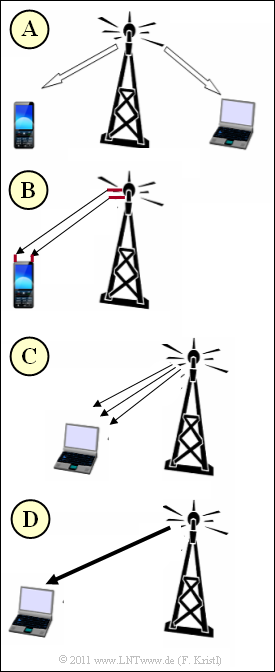Exercise 4.2Z: MIMO Applications in LTE
One of the many innovations of LTE is the use of multi-antenna concepts. However, the technology known as Multiple Input Multiple Output (MIMO) is not an LTE-specific development. For example, WLAN also uses this method.
The basic concept of MIMO is explained in the graphics in the theory part (example 2) Both the transmitter and the receiver are equipped with several antennas. This means that several data streams can be transmitted simultaneously. In addition to Single Input Single Output (SISO), LTE also supports 2x2 MIMO in the uplink and up to 4x4 MIMO in the downlink.
The advantages of MIMO technology are:
- a diversity gain and a Data rate gain for multiple connections,
- a higher signal-to-noise ratio (SNR) and a higher peak SNR at the same transmission power,
- lower required transmission power for the same quality requirements, or
- more redundancy in system implementation and thus a more robust system.
In most cases, not all advantages can be exploited simultaneously. Depending on the nature of the channel, it can also happen that you don't even have the choice of which of these advantages you want to use.
Four different multi-antenna methods with different characteristics are combined under the name "MIMO", which can be useful in certain situations:
- If the largely independent channels of a MIMO system are occupied by a single user, this is called 'Single-User MIMO’. This increases the data rate for this user by a factor of almost 2 for 2x2 MIMO and by a factor of almost 4 for 4x4 MIMO.
- At Multi-User MIMO one transmits different data streams to different users. This is especially useful in places with a high demand, such as airports or even football stadiums. The focus is therefore not on the maximum data rate for a receiver, but on the number of terminal devices that can use the network simultaneously.
- One speaks from beamforming when,in the case of poor transmission conditions, the transmission power of several antennas is bundled and thus data is transmitted to a (particularly important) user in a targeted manner in order to improve the quality of reception.
- With the help of antenna diversity one increases the redundancy and thus makes the transmission more robust against interference. For example, if there are four channels, they will all transmit the same message in this application. If one channel fails at some point, there are still three channels that can carry the message.
Notes:
This task belongs to the chapter Technische Neuerungen von LTE.
- In the adjacent diagram, the MIMO applications listed above are illustrated by highly simplified diagrams.
- In the subtask (1) you should assign the individual applications to the sketches.
Sample solution
Sample solution
- Sketch $\rm A$: Multi–User MIMO,
- Sketch $\rm B$: Antennendiversität,
- Sketch $\rm C$: Single–User MIMO,
- Sketch $\rm D$: Beamforming.
(2) Correct are the answers 2, 3 and 5. Diversity can always be exploited if the transmission conditions show useful differences:
- in different places ⇒ spatial diversity,
- at different times ⇒ time diversity,
- for different frequencies ⇒ frequency diversity
The other two terms used here are purely fictional.
(3) Correct are the answers 1, 4 and 5:
- As described in detail in the theory section, MIMO technology is used to achieve a diversity gain.
- This indirectly results in a better SNR and improved transmission quality through more robust systems.
- Interference, whether between cells or symbols, cannot be reduced by MIMO.
(4) Correct are the answers 1, 2 and 6:
- Durch Single–User MIMO werden höhere Datenraten für den einzelnen Nutzer erreicht.
- Durch Multi–User MIMO können mehr gleichzeitige Nutzer versorgt werden.
- Beamforming erhöht die Reichweite der Basisstationen.
Der Energieverbrauch wird durch MIMO–Technologie in keinem Fall niedriger, er steigt sogar an den Basisstationen wie auch am Endgerät an:
- Je mehr Antennen versorgt werden müssen, um so höher ist der Stromverbrauch.
- Aus diesem Grund gibt es momentan für Mobiltelefone noch das Limit von maximal zwei Antennen – die Batterielaufzeit wäre sonst zu kurz.
- An den Basisstationen fällt der höhere Stromverbrauch natürlich weniger ins Gewicht als bei der Vielzahl von Endgeräten.
- Es kann durchaus sein, dasss es durch MIMO und entsprechendes Controlling auch zu Verbesserungen hinsichtlich der Vorschläge 3, 4 und 5 kommt. Diese Verbesserungen sind dann allerdings indirekt.
